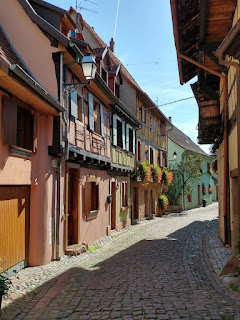A five minute walk took us into the town and through to the
Tourist Information Office where we were given a town trail map and we bought a
small guide book that gave us a bit more information. In Mediaeval times, the
town had a circular defensive wall and a moat. The moat has been filled in and
houses were built against and into the walls but the streets still follow the
circular shape and parts of the wall can still be seen in their structure. It
is an extremely pretty town and is a lovely combination of twee timber-framed houses
and a working town. Flowers are everywhere that adds to the attractiveness. As
we walked around, the perfume of fermenting grapes was ever present and many
working wineries are still in the very compact centre.
We walked every street in the compact town admiring the architecture and
looking at the inscriptions above the doorways, often showing the date of
construction and the initials of the owners. Some have a coat of arms or symbol
carved into the stone that indicates the trade of the owners such as a butcher’s
block or cooper’s tools. In a few cases there are more extensive inscriptions
on the wooden frames such as ‘Purify me, dear God’, ‘To praise everything, to
put up with everything, to agree with every troublemaker, who can get away with
that?’ and, very appropriate in this tourist Mecca, ‘Why stand gaping at me? Go
mind your own business’.
Another interesting feature of the town is the ‘tithe courts’. Much of the land
in the area was owned by wealthy landowners such as religious organisations.
They would then rent the land out to tenants who would pay rent by a tithe, a
portion of their produce. The owners needed somewhere to store these tithes and
built houses with large, secure courtyards. These are now owned mostly by wine
producers and are used as wineries and/or to provide tasting and sales
opportunities for visitors.
Photos: A typical Eguisheim street scene with houses on the
left and a (ex?) winery on the right; A doorway showing the construction date
of 1612 and the crossed cooper’s tools – the sword through the tools indicates
that the owner was a master craftsman; The main square of the town with its
castle and chapel devoted to Pope Leon IX who came from the town; One of the
largest tithe courts.




No comments:
Post a Comment